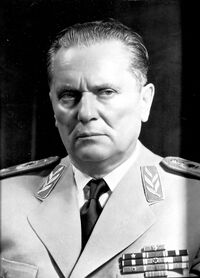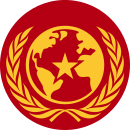More languages
More actions
Josip Broz Tito Јосип Броз Тито | |
|---|---|
 | |
| Born | 7 May 1892 Kumrovec, Croatia-Slavonia, Austro-Hungary |
| Died | 4 May 1980 Ljubljana, Slovenia, SFR Yugoslavia |
| Political orientation | Market socialism Titoism |
| Political party | League of Communists of Yugoslavia |
Josip Broz Tito (7 May 1892 – 4 May 1980) was a Yugoslav communist revolutionary and politician. He did not support the Soviet Union and instead founded the Non-Aligned Movement.[1]
Early life[edit | edit source]
Tito was born in Kumrovec on May 7th, 1892 to a large working-class family of 15 children and was one of the seven surviving children of Franjo and Marija Broz (née Javeršek).[2] Tito was a trade unionist and fought in the First World War, Russian Civil War (with the Red Army), and Spanish Civil War (with the Republican Dimitrov Battalion).[1]
Second World War[edit | edit source]
After the Spanish Civil War, Tito returned to Yugoslavia and fought a guerrilla war against the fascists. He survived all seven Enemy Offensives carried out against him and his army from 1941 to 1944. In May 1945, he became the premier of the newly created Socialist Federal Republic of Yugoslavia.[1]
Cold War[edit | edit source]
Between 1945 to 1948, Tito maintained relations with Stalin and the Soviet Union. However, conflict erupted between Tito and Stalin since Tito wanted Yugoslavia to accept the Marshall Plan package which Stalin rejected,[3] as well as wanting to incorporate Bulgaria and Albania into a Yugoslav federation.[4] After the break in 1948, Tito began requesting for US aid,[5] and even supported South Korea in 1950.[6]
In 1950, Tito introduced workers' self-management but also tolerated limited market influence. He also let Aleksandar Ranković continue the Serbian colonization effort in Kosovo.[7] Tito met with Jawaharlal Nehru and Gamal Nasser in Yugoslavia in 1956 and scheduled NAM's founding conference for 1961.[1] In the late 1960s and early 1970s, Tito tried to borrow from the IMF to expand the Yugoslav economy. When a recession began in the 1970s, the West banned all exports from Yugoslavia and forced Yugoslavia to restructure its economy by cutting social spending, freezing wages, eliminating worker-controlled enterprises, and increasing unemployment. Economic growth dropped from 7% per year in the late 1960s to under 3% by the 1980s and was negative by 1990.[8]
Death[edit | edit source]
Tito died on May 4th, 1980 in UMC Ljubljana from a gangrene-induced infection on his left leg. Tito's death is regarded as one of the main causes for the collapse of Yugoslavia a mere decade later.
References[edit | edit source]
- ↑ 1.0 1.1 1.2 1.3 Vijay Prashad (2008). The Darker Nations: A People's History of the Third World: 'Belgrade'. [PDF] The New Press. ISBN 9781595583420 [LG]
- ↑ Ivo & Slavko Goldstein (2015). Tito (p. 27). Profil. ISBN 9789533134178
- ↑ Lampe, John R.; et al. (1990). Yugoslav-American Economic Relations Since World War II (pp. 28–37). Duke University Press. ISBN 9780822310617
- ↑ Perović (2007). The Tito–Stalin Split: A Reassessment in Light of New Evidence (pp. 43-44 and p. 52).
- ↑ "Yugoslav Revisionism". The Espresso Stalinist.
- ↑ "The Ambassador in Yugoslavia (Allen) to the Secretary of State" (1950-07-06). Office of the Historian.
- ↑ "Where is the Nationalism of Tito’s Group in Yugoslavia Leading To?" (1948-12-08).
- ↑ Michael Parenti (2000). To Kill a Nation (pp. 19-21).
